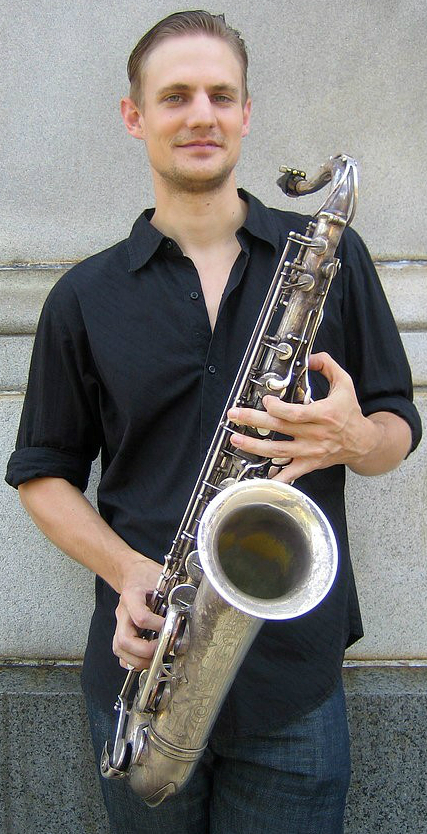Steve Kortyka Discusses Utilizing 5 Note Groupings & Building Your Memory By Using Loops
Introduction
If you have listened to Tony Bennett & Lady Gaga, you might be wondering, who is that killing saxophonist backing up these two famous entertainers? If you don’t know, this is Steve Kortyka. I recently reached out to Steve to take a skype lesson and during my lesson, Steve shared two concepts with me that I thought would be great information for BSWE readers to check out. These two concepts will help all of us improve our rhythmic approach by utilizing 5 note groupings and improve our memorization skills by using loops to break down solo’s we transcribed. Per Steve’s permission, I am sharing some of the material we went over. Before we discuss these topics, I am going to share a bit about Steve if you already don’t know who he is and what he has accomplished thus far.
Biography
Based out of Astoria, NY, Steve Kortyka is an accomplished multi-instrumentalist, composer and educator. Originally from Cleveland, Ohio, Steve began playing saxophone at a young age. Upon graduating from The Cincinnati College Conservatory of Music under the tutelage of Rick VanMatre and James Bunte, he became a full time working musician in the cruise industry where he was quickly promoted to Musical Director. After working in the cruise industry, Steve arrived in NYC in 2011 where he has had the opportunity to perform at such famous venues as: The Blue Note, Smoke, Shapeshifter, Fatcat, Smalls, and Birdland just to name a few. Steve has made numerous major network television appearances on shows including ‘The Jimmy Fallon Show’, ‘Strictly Come Dancing’ (U.K.), ‘Good Morning America’, ‘Christmas at Rockefeller Center’, ABC’s ‘A Very Gaga Thanksgiving’, PBS’s ‘Great Performances’ and ‘NYE Live at Rockefeller Center with Carson Daly’. In addition to these television appearances, Steve serves as musical director for the Brian Newman Orchestra and septet for the band’s recent appearances at the Rainbow Room and The Iridium in Manhattan.
Currently, holding a residency at the Gramercy Park Hotel’s Rose Bar every Tuesday and Thursday with the Brian Newman group as well as the AKA hotel every Wednesday with a guitarist duo, Steve is an active performer on the New York scene frequently engaging in collaborative projects with some of the finest musicians in the world today. Steve has released 2 albums under his own name (‘Wedding Song’ and ‘Steps Forward’) as well as a co-leading an album (‘Oh-Ja’) with organist (and fellow Brian Newman musical director) Alex Smith. Some recent performance highlights include performing at Tony Bennett’s 90th birthday celebration along side Steve Wonder and Lady Gaga, as well as performing at the B&T Pavilion in Philadelphia for the DNC convention.
Steve will soon be releasing a new album in the fall with his quartet that will feature original cmpositons by each of the members in the band, and has written some arrangements featured on the “Eyes on the City” album recorded by the Brian Newman quintet at Avatar Studios in 2015. From an education standpoint, Steve has an improvisation method book which he was a co-writer on with Shawn Wallace (Professor at OSU), Keith Newton, and Kris Johnson that will be released by Hal Leonard in the fall (October – Published by Hal Leonard – title TBA).
Lesson Part 1: Utilizing 5 Note Groupings (Please see link below)
Overview
Steve discusses various diatonic patterns that should be practiced in all 12 keys as well as different variations. Steve demonstrates these 5 note patterns with various rhythmic approaches and using one of John Coltrane’s chromatic approach phrases as an example. These examples give the player a good idea of how these 5 note patterns can sound if played properly and practiced with a metronome. Steve further demonstrates this concept over Rhythm changes.
Lesson Part 2: Build Your Memory Using Loops (Please see link below)
Overview
Steve discusses building your memory using loops and utilizes a passage from Seamus Blake’s solo on Invitation. When transcribing, it is best to avoid writing anything down until you believe you have it memorized. By looping portions of the entire passage, your able to isolate various patterns that you might be struggling with as well as better understand what in this instance Seamus was playing over the chord. As you internalize various parts of the passage by looping, you should start connecting these lines in small increments to get closer and closer to having the entire passage under your fingers. By using Steve’s method, you will be able to memorize larger amounts of licks or phrases in a shorter period of time.
Building Your Memory Using Loops
Conclusion
I would like to thank Steve for sharing these two concepts which I know all us saxophone players will greatly benefit from in our practice sessions. I am looking forward to the release of the publication he contributed in the Fall and if you have not already been checking out Steve’s music or are possibly looking for a private teacher, I highly recommend contacting Steve.
Equipment:
Saxophone
Soprano: YSS82Z
Alto: YAS62IIIS
Tenor: YTS82ZS
Clarinet: YCL-52
Flute: YFL-411II
Mouthpiece
Soprano: V16 S8
Alto: V16 A+8
Tenor: V16 T7 hard rubber mouthpiece
Ligature
M/O Ligature on all mouthpieces
Reeds
Vandoren ZZ 2’s on
Skype Lessons







September 1, 2016 @ 3:40 am
Doron; hi man. Apologies for stuffing this in here. Got your mail but the return address failed. Be good to catch up, so if you can mail me a valid address, I’ll get right back. Have a groovy day. Ade UK.
November 6, 2016 @ 1:02 pm
Great article, thanks Zach!